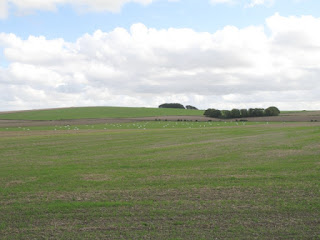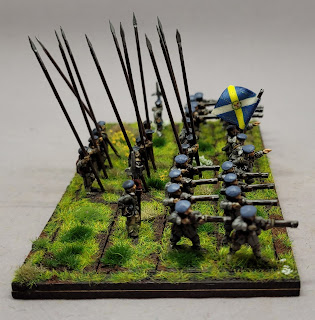Battle of Roundway Down, 13th July 1643
After a hiatus, the adventures of William Waller's Southern Association continue...
After the battlefield defeat (and campaign stalemate) of Lansdowne the now reinforced Southern Association shadowed Hopton's army and took position on Roundway Down, above Devizes on the 8th July.
Hopton's army had been joined by Prince Maurice's and the Marquis of Hertford's forces to form The Army of The West. As Hopton had been temporarily blinded the Royalist command decided to retreat and regroup in Oxford.
Waller put the town under siege; Maurice's cavalry, of little use in a siege broke out and he headed to Oxford, whilst the Regiments of Horse dispersed over Wiltshire. Waller stepped up the pressure and brought his artillery to bear upon the town.
Charles was not in Oxford; Lord Wilmot decided to relieve the siege with just a cavalry force made up of two brigades of Oxford Horse; this was joined in Marlborough by another brigade of horse under Crawford and some of the Western Horse who had escaped from the town. Wilmot's force now consisted of 1800 cavalry.
Waller faced Wilmot with 2500 foot, 2500 horse and 8 guns; most importantly to the rear of his lines was the precipitous escarpment that has Oliver's Castle on it's southern end, and Beacon Hill to it's north.
After some initial skirmishing Wilmot charged, taking Waller's artillery; many of the Southern Association fled for their lives, the vast majority of their cavalry casualties riding over the steep face of the escarpment to their deaths.
Roundway is where Captain Atkyns famously shot Sir Arthur Hessilrigge at point blank range (Atkyns' pistol was touching Hesilrigge's cuirass). Sir Arthur was dazed but unharmed. Atkyns wrote
Hopton's army had been joined by Prince Maurice's and the Marquis of Hertford's forces to form The Army of The West. As Hopton had been temporarily blinded the Royalist command decided to retreat and regroup in Oxford.
Waller put the town under siege; Maurice's cavalry, of little use in a siege broke out and he headed to Oxford, whilst the Regiments of Horse dispersed over Wiltshire. Waller stepped up the pressure and brought his artillery to bear upon the town.
Charles was not in Oxford; Lord Wilmot decided to relieve the siege with just a cavalry force made up of two brigades of Oxford Horse; this was joined in Marlborough by another brigade of horse under Crawford and some of the Western Horse who had escaped from the town. Wilmot's force now consisted of 1800 cavalry.
Waller faced Wilmot with 2500 foot, 2500 horse and 8 guns; most importantly to the rear of his lines was the precipitous escarpment that has Oliver's Castle on it's southern end, and Beacon Hill to it's north.
After some initial skirmishing Wilmot charged, taking Waller's artillery; many of the Southern Association fled for their lives, the vast majority of their cavalry casualties riding over the steep face of the escarpment to their deaths.
 |
| Looking down the escarpment towards Bloody Ditch For a sense of size and steepness of the slope here's a short video of drone footage of the escarpment via Hedley Thorne on Twitter @thoneh . The escarpment also appears in the film version of 1984 staring John Hurt - it is Winston Smith's dream landscape, and where he first meets up with Julia. |
Roundway is where Captain Atkyns famously shot Sir Arthur Hessilrigge at point blank range (Atkyns' pistol was touching Hesilrigge's cuirass). Sir Arthur was dazed but unharmed. Atkyns wrote
Twas my fortune in a direct line to charge their General of Horse, which I suppos'd to be so by his place; he discharged his Carbine first, but at a distance not to hurt us, and afterwards one of his Pistols, before I came up to him, and mist with both: I then immediately struck in to him, and touchd him before I discharged mine; and I'm sure I hit him, for he staggerd, and presently wheel'd off from his Party and ran.
Those members of the Southern Association that successfully fled the battlefield escaped because of a forlorn hope rearguard action at Beacon Hill.
What's There Now?
What's There Now?
 |
| Two cannon ball holes in St James's tower |
St James's Church
 |
| Damage close to the Beauchamp window, west end of St John's |
and St John's Church both bear scars from Waller's artillery bombardment.
 |
| View of the traditional battlefield site |
The battlefield itself - there is some speculation as to where exactly on the Down the battle took place; traditionally the two sides are positioned north and south of one another, with the Southern Association having Devizes to their backs. This site is best viewed from the Millenium White Horse parking area.
More recent studies, along with analysis of cannon balls, shot and skeletal remains moves the action further west with the fighting centring upon the car park for Oliver's Castle - such a location would also lend itself to Waller's men having their backs to the steep escarpment face.
The escarpment which plays such a large part in the battle is normally the site of Battlefields Trust interpretation panels. But sadly they were recently vandalised and have now been removed.
Looking down the escarpment face one can clearly see how so many Parliamentarian horse lost their lives: the ditch at the bottom is locally called Bloody Ditch, and it is believed many soldiers and their horse still lie on the slopes of the escarpment. A possible burial pit awaits further archaeological investigation. With approximately 600 men dying in this area, you can understand why the Bloody Ditch appears in many 'most haunted' lists.
The escarpment which plays such a large part in the battle is normally the site of Battlefields Trust interpretation panels. But sadly they were recently vandalised and have now been removed.
One is located close to the car park, from here follow the path west towards
Oliver's Castle, now follow the path that skirts around the fields close to the western edge of the escarpment northwards...
...towards Beacon Hill, from here follow the lane eastwards towards Hill Cottage, you come to a crossroads: a footpath turning on your left (northwards) the lane becomes a made road (eastwards) and a lane turns right (southwards) back to the carpark. This where the fourth board is normally located
For a view of the traditional battle site the car park of the Millennium White Horse gives the best views.
Looking down the escarpment face one can clearly see how so many Parliamentarian horse lost their lives: the ditch at the bottom is locally called Bloody Ditch, and it is believed many soldiers and their horse still lie on the slopes of the escarpment. A possible burial pit awaits further archaeological investigation. With approximately 600 men dying in this area, you can understand why the Bloody Ditch appears in many 'most haunted' lists.
 |
| Cannon balls found at St James's Church, now on display at Devizes Museum |
Down in Devizes itself is the Wiltshire Museum which has a number of artefacts relating to the Battle.
Selected Bibliography
The Most Heavy Stroke: The Battle of Roundway Down 1643 Chris Scott, Helion Press
Postcodes for SatNavs
Parking for the Oliver's Castle SN10 2JF
Selected Bibliography
The Most Heavy Stroke: The Battle of Roundway Down 1643 Chris Scott, Helion Press
Postcodes for SatNavs
Parking for the Oliver's Castle SN10 2JF
Battlefield Interpretation Board sites
Parking for Millenium White Horse SN10 2HY OS grid SU014641
St James's Church, Church Walk SN10 3AA
St John The Baptist, Long Street SN10 1NP
Wiltshire Museum, Long Street SN10 1 NS
- Car Park OS grid SU004647
- Oliver's Castle OS grid SU001646
- Beacon Hill OS grid SU001653
- Crossroad fourth board OS grid SU005653
Parking for Millenium White Horse SN10 2HY OS grid SU014641
St James's Church, Church Walk SN10 3AA
St John The Baptist, Long Street SN10 1NP
Wiltshire Museum, Long Street SN10 1 NS
If you enjoyed reading this, or any of the other posts, please consider supporting the blog.
Thanks.













Interesting as ever. The number of times I've driven through Devizes on the A361 and not clocked that Roundway Down was so close...
ReplyDeleteThanks Dex. Might be useful keeping an eye on the Battlefields Trust website/Twitter and visiting once the new information boards are in position. (I believe that they are hoping to replace them soon.)
DeleteRichard Atkyns' frustrated attempt to slay Sir Arthur led to King Charles' one good joke...
ReplyDeleteHave to say that those old ECW generals had the unerring ability to pick the most picturesque battle fields.. and Roundway is certainly one of my favourites - it is beautiful up there on a sunny summer day... must get back soon.
ReplyDeleteI know what you mean Steve. My own favourite is Cropredy Bridge. I remember sitting near Slat mill thinking how tranquil and calm it was there, quite poignant for somewhere that saw so much blood shed.
Delete